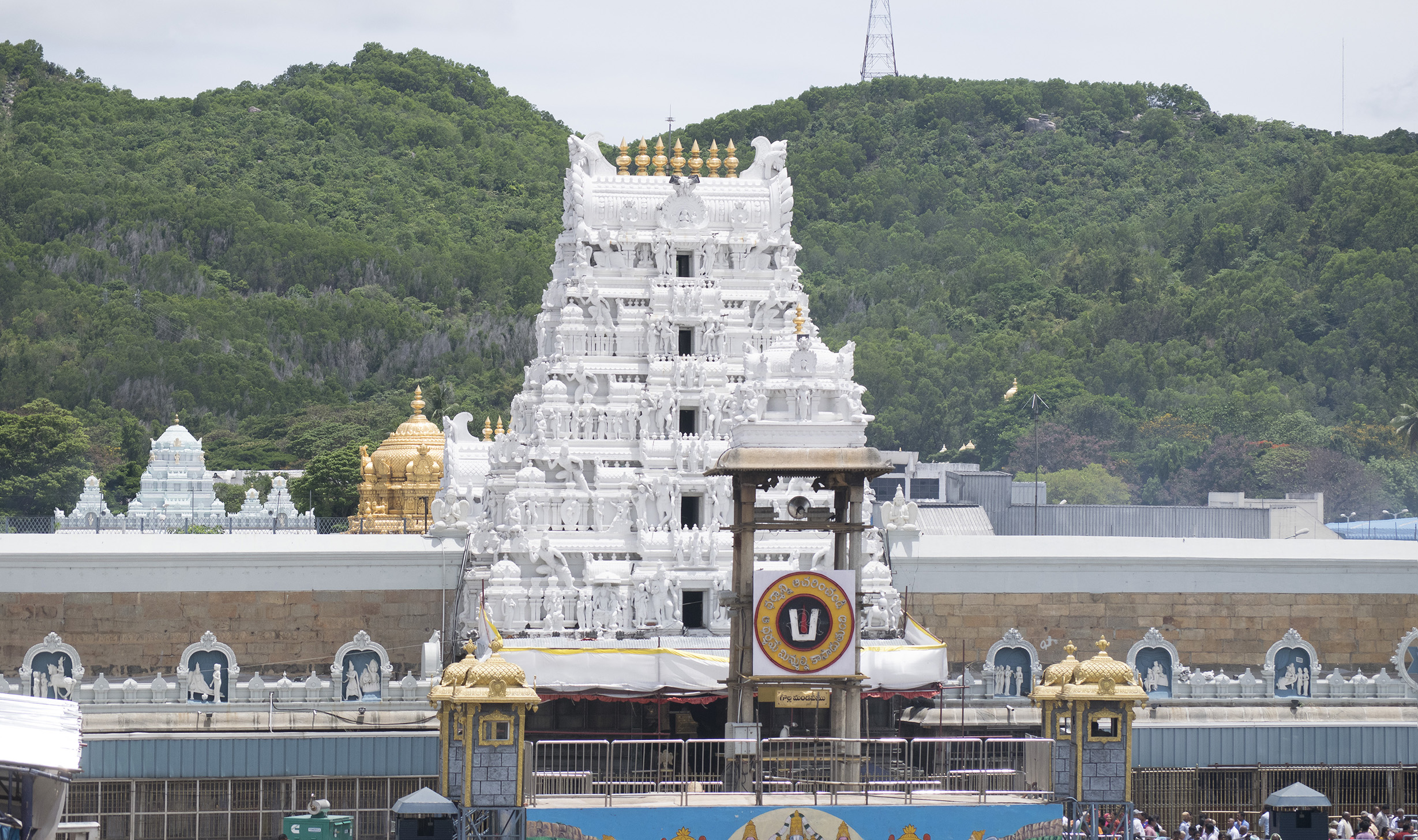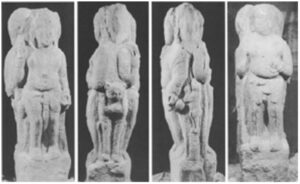The Srimad Bhagavatam is a treasure house of Indian culture. It is many things combined: a manual on ethics, a work on social and political philosophy, a study of duty and human relationships, a book on religion and the attainment of the truth.
The epic, Bhagavatam is an important and sacred epic of India. Probably, no literary work in its origin, has ever produced so profound an influence on Indian life and culture as this epic. In this paper an attempt is made as to the origin and development of Bhagavata cult in Andhra Pradesh.
Members of the earliest recorded Hindu sect, the beginning of the theistic, devotional worship and modern Vaishnavism. The sect originated in the Mathura region and spread throughout India and Andhra was too came under its sway. The faith centers on devotion to a personal god, variously called Vishnu, Krishna, Hari or Narayana. The Bhagavad Gita is the earliest exposition of the system but its central scripture in the Bhagavata Purana. The Bhagavata Purana also known as Srimad Bhagavatam or simply Bhagavatam is well known among all the Purana and is an important literature of Hinduism.
After the four Vedas, the Puranas form the most sacred texts of the Hindus. The highest philosophy found in Vedas and Upanishads was difficult for the commoners to understand and hence the Puranas, which were recited at the time of sacrifices, became popular. The eighteen Puranas deal with eighteen different deities: Brahma, Padma, Vishnu, Siva, Garuda, Narada, Bhagavata, Agni, Skanda, Bhavishya, Brahmavaivarta, Markandeya, Vamana, Varaha, Matsya, Kurma and Brahmanda.
The Bhagavata Purana is popular because it focuses on Bhakti Yoga (devotion to the supreme Lord expressed through love) Vishnu or Krishna is understood as the Supreme lord. Bhagavata Purana consists of eighteen thousand slokas, distributed amongst 332 chapters and divided into twelve cantos (skandhas). It is named Bhagavata from its being dedicated to the glorification of Lord Vishnu. Though original written in Sanskrit, the Bhagavata Purana has been explored and translated in many vernacular languages of India. An epic philosophical and literary classic, it holds a prominent position in India’s voluminous written wisdom. Bhagavatam exercises a more direct and powerful influence upon the opinions and feelings of the people than perhaps any other of the Puranas. History suggests that the text was written in the 9th or 10th century. However, Hindu religious tradition holds it to be one of the works of Vyasa written at the beginning of Kali Yuga (about 3100 BC).
The epics and Puranas refer to Vishnu, Narayana and Vasudeva Krishna1 as almost one and his devotees are called either as Vaishnavas of Bhagavatas2 or Sattavatas3 or Ekantikas4 or Pancharatras.5 But these are found to be three different cults fused into one during the Upanishadic period. The first important step in the evolution of Vaishnavism is the Vasudeva cult developed around Vasudeva-Krishna the leader of the famous epic race the Yadus with its branches the Sattavatas and Vrhshis.6 Vasudeva-Krishna was the disciple of Ghora Angirasa of the Chandyogya Upanishad who laid the foundations of the monotheistic religion, independent of the Vedic tradition and with emphasis on ethical requirements such as dana, arjava and ahimsa.7
It is generally agreed that Vasudeva-Krishna played a prominent part in the events recorded by the Mahabharatha.8 Buhler thinks that the worship of Krishna “dates from the time long anterior to the rise of the Jains in the 8th century B.C.”9 By the time of Panini (5th century B.C.) the Vasudeva cult became an established religion among the Sattavatas and Vrishnis.10 In the course of time Vasudeva Krishna came to be identified with Narayana and Vishnu who were held supreme among the Brahmanists. Narayana was yogisvara and he became supreme through the Pancharatra, sattra.11 Slowly Vasudeva was identified with him and the Vasudvaka and the Pancharatrakaas got mixed up12 and came to be known as the Bhagavatas. Soon afterwards the god of the Bhagavatas was identified with Vishnu as a result of a double pronged move. On the other hand the Brahmanists found in the popular Bhagavata cult an effective means of checking the progress of atheistic Buddhism. Therefore “Brahmanism claimed as its own this popular and powerful representation of the deity (i.e. Krishna) and transformed it into an incarnation of Vishnu. In this way Brahmanism succeeded in gaining over the entire community of the Bhagavatas and the latter (still existing sect) were merged in Brahmanism”.13
Thus by the time the Mahabharata and the Bhagavad Gita were composed “three streams of religious thought – the one flowing from Vishnu the Vedic go at its source, another from Narayana the cosmic and philosophic god and the third from Vasudeva, the historical god mingled together decisively and thus formed the later Vaishnavism.14
The Bhagavata Purana claims that the Andhras, like many other uncivilized tribes, were purified by their adherence to Vaishnavism.15 Vaishnavism entered Andhra sufficiently early. Many of the Andhra ruling families showed preference to Vaishnavism till it became predominant after it was activated by Ramanujacharya in the 12th century A.D. The early Satavahanas appear to have been influenced by Vaishnava Bhagavatism. The second king in the Satavahanas16 according to Matsya list, is Krishna or Kanha and the mane must have been the result of that influence. On the basis of the Chinnaganjam inscription17 of Yajnasrisatakarni’s reign, D.C. Sircar concludes that the “Vasudeva cult spread up to the east coast by the close of the 2nd century A.D. The Saptasati which is generally attributed to the 17th king in the Satavahana dynasty contains many gathas with Vaishnaaite themes. They are: Krishna and the churning of the ocean of milk18, Yasoda, Gopikas and Krishna19 Vamana20 and Trivikrama.21 Recently a large panel of sculpture was discovered at Kondmotu in the Paland Taluk of Guntur district.22 It contains from the left, the images of Pradyumna, Vishnu, Narasimha, Vasudeva, Sankarshana and Aniruddha. On stylistic grounds, the panel is assigned to the late phase of the Ikshavaku sculpture or to about the close of the fourth century A.D.23 In the time of Ehuvala Chantamula an image of Ashtabhuja Narayana on the Sethgiri24 was consecrated. This event took place in the 30th year of his rule i.e. about A.D. 270.25 This amply proves that Vaishnavism was introduced into the Nagarjunakonda valley; where there had been Buddhism and Saivism. The name Ashtabhuja Narayana of Vishnu indicates the growth of Vaishnavite mythology at such an early date as A.D. 250. According to Bhagavata Purana26 Daksha, after he was revived to life, invoked Vishnu as Asthabhuja-Narayana. This image might have inspired the sculptors at Undavalli to produce Trivikrama with eight arms.27 The Pallavas who destroyed the Iskhavakus of Vijayapuri might have carried this conception of Narayana and built for him a temple at Kanchi. One of the early Alvars Pey makes references to “Attapuyakaram” (Ashtabhuja) at Kanchi.28 Most of the early Pallava kings were Vaishnavas as indicated by their very names. Nandivarma of the Salankayana dynasty was a Paramabhagavata and he made gifts to Vishnugrahasvami.29
The early members of the Chalukyan dynasty, who replaced the Vakatakas in the west and the Vishnukundins in the east were devotees of Vishnu. Pulakesin I who proclaimed the Chalukyan supremacy by performing the Asvamedha took the title Sri Prithvi Vallabvha,30 which means the Lord of the goddesses of wealth (Sri) and Earth (Prithvi). His successors continued the title. During the time of Kirtivarma I–Mangalesa31 took the title Parambhavagavata.32 Kubjavishnuvardhana, the founder of the Eastern Chalukyan line also had that title and he named his son Jayasimha. Varaha the sacred Boar was the crest of the Chalukyas.33
During the Pallava-Chalukya period, Tirupati and Nellore became important centres of Vaishnavism. Though the earliest inscriptional reference to Tirupati comes from about the middle of the 9th century, there is plenty of literary evidence about the existence of Tirumala-Tirupati from very early times. In the compositions of the Alvars collectively known as the “Nalayira Divya Prabhandham”, there are nearly 300 references to Tirupati.34
Hence it can be surmised that Andhra Desa was much influenced by Vaishnavism from early times. It housed many Vaishnava temples and mathas which imparted education and teachings of the Vaishnava philosophy.
References
1. Suvira Jaiswal, Origin and Development of Vaishnavism, p.32.
2. Different meanings are suggested to this word. Pancharatra Sattar, Ibid., pp. 42-44.
3. Ibid.,
4. Ibid., 40.
5. Ibid., 42.
6. Wd. Hill Bhagavadgita, Introduction.
7. D.C. Sircar, Bhagavadgita, HCIP II, pp.431.
8. K.A.N. Sastry, D.R.S.I. p.37.
9. D.P. Pai, Religious Sects in India, p.14.
10. R.P. Chanda, Archaeology and Vaishnava Tradition, p.166.
11. Suvira Jaiswal. op.cit., p.35.
12. R.G. Bhandarkar, Vaishnavism, Saivism Minor Religious Systems, p.35.
13. Grierson, “Bhagavatism”, p.32.
14. R.G. Bhandarkar, op.cit., p.35.
15. Bhagavatapurana, IV 4, 18.
16. Epigraphia Indica, VIII Nasik Inscription No.32.
17. Ibid., Vol. I, pp.95-96.
18. Saptasati-II 17.
19. Ibid., I-89.
20. Ibid., II-12.
21. Ibid., V-11.
22. Waheed Khan, An Early Sculpture of Narasimha, Passim.
23. This is date arrived based on the ichnographical systems.
24. E, I. Vol XXXII, p.87.
25. R. Subramanyam, A Catalogue of Ikshvuku coins, p.19.
26. Ibid., pp.247-48.
27. S.I.I. Vol. VI, No.202.
28. S.K. Aiyangar, Studies in South Indian Jainism I, p.36.
29. Pedavegi Plates J.A.H.R.S. I pp.92-102.
30. Early History of Deccan I, p.208.
31. R.G. Bhandarkar, op.cit., p.61.
32. Venkatarasmanayya, N. Chalukyas of Vengi, p.290.
33. S.K. Aiyangar, A History of Tirupati, I ch.3.
34. Ibid.,
V. Mallikarjuna Reddy, Ph.D.,
Academic Consultant
Department of History, S.V. University, Tirupati
Source: Journal of Indian History and Culture, September 2013, Nineteenth Issue




